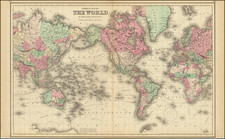Extremely rare Petrus Kaerius double hemisphere World map, based upon Plancius's map of 1594, the first printed map to include decorative allegorical figures to embellish the area surrouding the hemispheres.
First issued in 1604, Shirley refers to the map as very rare, with only 3 or 4 known examples of the two states of the map, although we believe the count to be higher.
This striking map of the world engraved by the Dutch master Josua Van Den Ende, who also engraved Guillaume Blaeu's landmark world map and a number of rare wall maps of the World. The elaborate borders were inspired by drawings in the works of Theodore de Bry, published a few years earlier, and established a pattern of cartographical decoration that lasted over a century and are drawn from Plancius, but have been reversed in their positioning.
The map has great importance geographically, particularly in the mapping of the Arctic and the Far East. The map contains a marvelous attempt at a North-West Passage. Plancius himself instigated the three voyages of Willem Barents (1594-1597) into the area. He used this map to give cartographic encouragement to the Dutch crews by turning Novaya Zemlya into an island, with open sea between it and the Arctic. A sprinkling of English names in the Canadian Arctic appear as a result of Frobisher and Davis's explorations in search of the passage in 1576-1587.
The map is also a landmark in the mapping of Asia and Japan. Plancius was one of the first Europeans able to penetrate the wall of secrecy surrounding the manuscript portolan maps produced by Spain & Portugal, and his observations are copied here by Kaerius. Some of the most significant improvements include the first incorporation of Teixiera's outline for Japan.
This is the first time we have ever seen this map offered for sale on the market.









![[ Ancient World ] Christianographie](https://storage.googleapis.com/raremaps/img/small/80305.jpg)
![Western Hemisphere [and:] Eastern Hemisphere](https://storage.googleapis.com/raremaps/img/small/102187.jpg)
![[Early Photographic Facsimile of the Catalan-Estense World Map]](https://storage.googleapis.com/raremaps/img/small/66756.jpg)
![[World -- Terrestrial Globe Gores]](https://storage.googleapis.com/raremaps/img/small/89195.jpg)
![[ Game Board World Map -- Gulf of Korea named ] Walker's Geographical Pastime Exhibiting a Complete Voyage Round the World in Two Hemisphere with Tetotum, Pillars & Counters, for Playing This Highly Interesting Game.](https://storage.googleapis.com/raremaps/img/small/102691.jpg)
